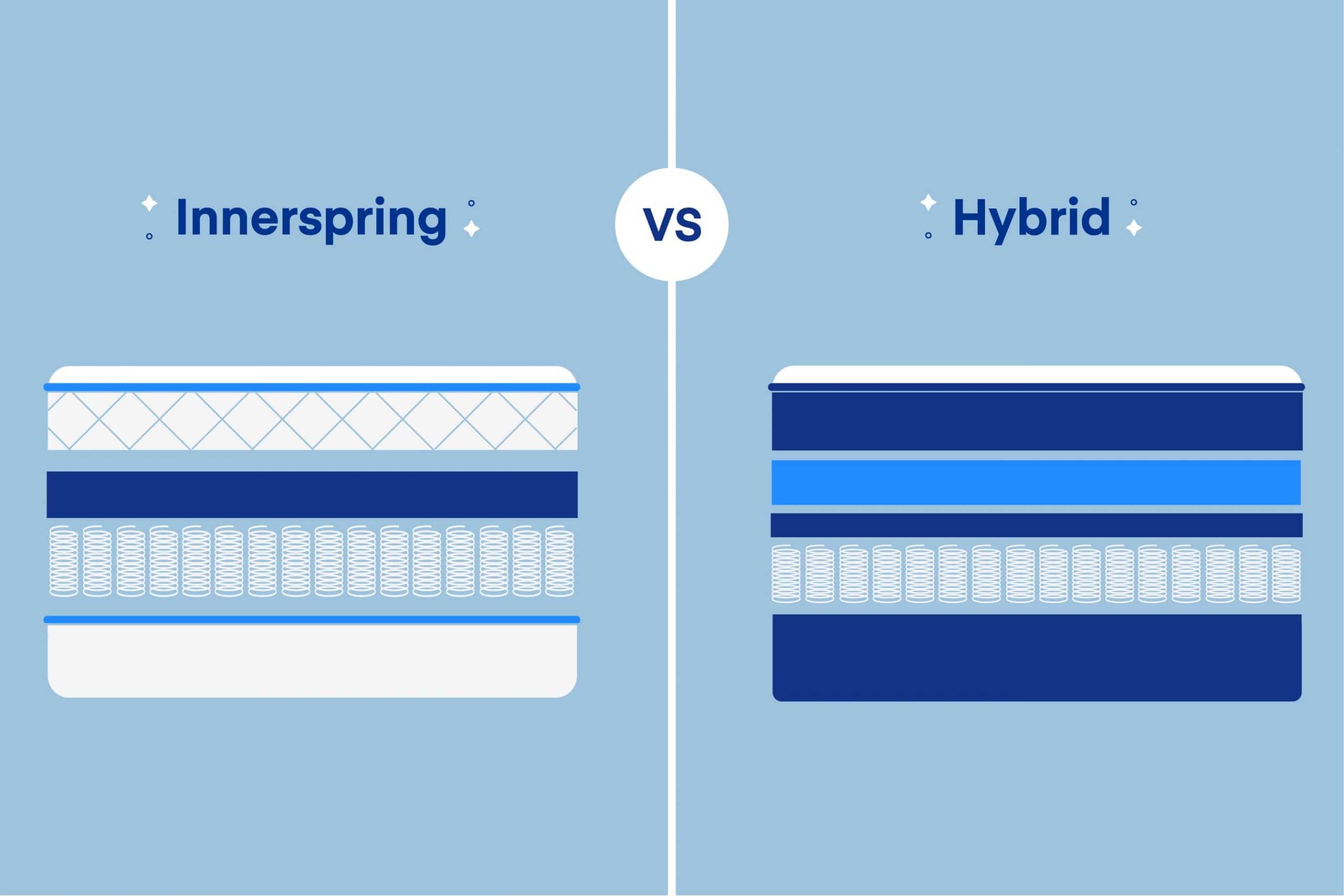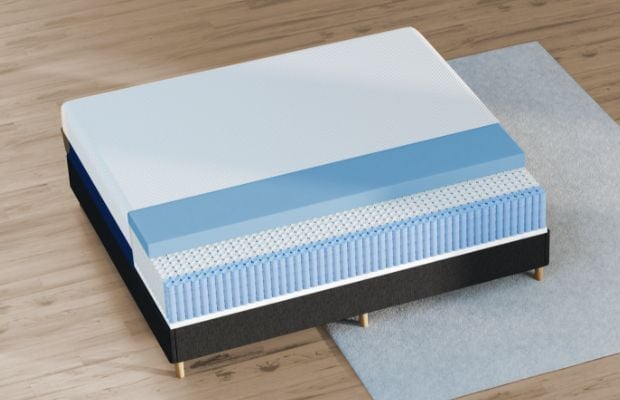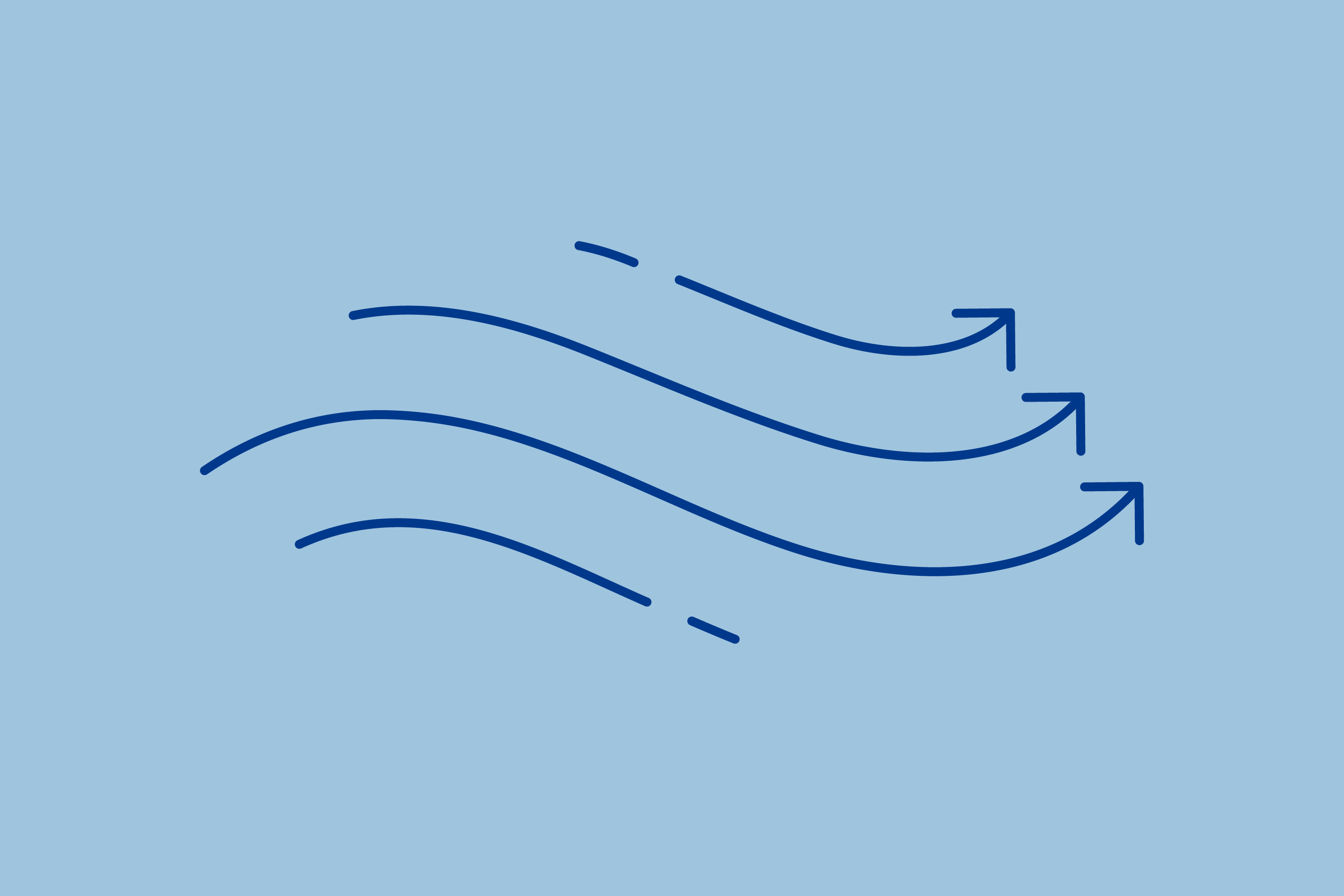Key Takeaways
- What Are Hybrid Mattresses: Hybrid mattresses combine the benefits of coil support with the comfort of memory foam or latex. They offer a balance between bounce and body-contouring. Hybrids consist of multiple layers, including a comfort layer (usually 2 inches of memory foam or latex), a transition layer, a coil support structure (often pocket coils), and a base layer.
- What Are Innerspring Mattresses: Innerspring mattresses primarily rely on coil support and have thinner comfort layers. They offer a firmer feel with more bounce but can transfer motion and may lack conforming support. Coil gauge and coil count are factors to consider.
- Picking the Right Mattress: Memory foam and latex mattresses are alternatives to hybrids and innersprings, each with its unique characteristics. When choosing a mattress, consider your body weight, sleeping position, and preferences to find the most suitable option. Reading mattress reviews can also help in the decision-making process.
Hybrid mattresses have brought back the benefits of coils while negating the drawbacks of an innerspring mattress. Both hybrids and innersprings have a coil system as their base support structure.
To enjoy body-contouring, plush memory foam, you don’t have to give up on the bounce of coils. Hybrid mattresses combine the responsive support of a coil mattress, with the soft conforming feel of memory foam. On the other hand innersprings have a thinner comfort layer made of cotton, polyurethane, or memory foam.
Hybrids are, essentially, evolved innerspring mattresses, bringing to you a perfect balance of comfort and support.
In this post, we discuss the similarities and differences between hybrid and innersprings to help you find your best mattress.
What Is a Hybrid Mattress?
If you are shopping for a hybrid mattress, check for a coil layer in the support structure, topped with at least two inches of memory foam or latex in the comfort layer. Mattress manufacturers use the term “hybrid” for any bed with a mix of different materials, but a true hybrid must have a coil base with at least 2 inches of foam on top.
Components of a Hybrid Mattress
Hybrids contain several layers, making them a heavier bed compared to others such as innerspring, or memory foam.
Comfort Layer
Hybrid mattresses have a comfort layer with at least 2 inches of latex or memory foam for a cushioning effect. The plush comfort layer conforms to your body providing contouring support and pressure relief.
Transition Layer
Some hybrid beds may have a transition layer made of firm poly-foam to reduce pressure on the support structure and enhance mattress durability.
Core Support Structure
Hybrids must have a coil system as their base support structure. Some of the more popular hybrid mattresses today feature pocket coils that are individually wrapped in fabric or encased in foam, reducing motion transfer.
Base Layer
A layer of high-density poly-foam beneath the pocketed coils enhance support and provide shock absorption.
Pros and Cons of a Hybrid Mattress
Hybrids combine the benefits of springs with memory foam or latex, but doing so comes with certain drawbacks.
Pros:
- Promotes airflow
- Provides extra support and bounce
- Reduces motion transfer
- Provides body-conforming, pressure-point relief
- Comfortable for all sleeping positions
Cons:
- More materials push the price up
- Heavier due to multi-layer composition
- Coil tension may decrease leading to sagging
Who Can Sleep on a Hybrid?
Hybrid mattresses are versatile, catering to a variety of sleepers. Since the firmness for most hybrid mattresses ranges from medium-soft to medium-firm, here are our recommendations depending on your sleep style, body type, and personal needs.
Side Sleepers
For side sleepers, a softer hybrid mattress may be a perfect fit. The thick comfort layers contour to your body providing adequate support, especially in the hip and shoulder regions.
Back Sleepers
In back sleepers, a medium hybrid’s foam layer conforms to the spine’s natural curvature, enhancing lumbar support. The coil layer at the base provides give to the mattress, promoting spinal alignment.
Stomach Sleepers
A medium-firm hybrid suits stomach sleepers because the firm comfort layer backed with coil support prevents sinkage and spinal misalignment.
Combination Sleepers
Combination sleepers may benefit from a medium hybrid because the pocket coil layer provides resilience making it easier to change positions during sleep.
Hot Sleepers
Hybrids are beneficial for hot sleepers because coils promote airflow, improving mattress breathability by making it cooler.
Lightweight Sleepers (weigh less than 130 pounds)
Lightweight sleepers who prefer some bounce in their bed may like a medium-soft hybrid. The option of a soft memory foam layer on top gives them the body-conforming feel, while the coil layers add a bounce.
Average Sleepers (weighing between 130 to 230 pounds)
Hybrids are perfect for average sleepers because the coil layer and the medium-firm comfort layers provide a perfect balance of cushion and support for their average size.
Plus Size Sleepers (weighing above 230 pounds)
A medium-firm hybrid will be a good fit for plus size sleepers. A firmer foam layer and extra support from the coil layer prevents them from feeling a “sink” into the mattress, as they enjoy the body-conforming feel of a medium-firm comfort layer.
Couples
Pocketed coil layers in hybrids reduce motion transfer, making them a good option for couples.
People who like extreme soft may prefer an all-foam bed, while those who want extreme firm may want an innerspring mattress.
Amerisleep Hybrid Mattresses
Quick Guide: A 30-Second Summary
| Best Hybrid Mattress Overall | Amerisleep AS3 Hybrid |
| Best Soft Hybrid Mattress | Amerisleep AS5 Hybrid |
| Best Natural Hybrid Mattress | Amerisleep Organica |
We have recently introduced hybrid mattresses, which are available in various firmness options. Our hybrids are designed to sleep cooler and enhance your sleeping experience. The soft and ultra-breathable mattress cover prevents overheating, as plant-based Bio-Pur® foam keeps you cooler than traditional foam. It conforms to your body, providing pressure-point relief and alleviating pain.

Our Amerisleep mattresses come with a risk-free 100-night sleep trial period, where you can try the mattress at your home. Like all of our mattresses, the hybrids are also backed by a 20-year warranty.
Pricing for Amerisleep’s Hybrid Mattresses
| Mattress | Firmness Level | Price |
|---|---|---|
| AS3 Hybrid | Medium | $1499 |
| AS5 Hybrid | Soft | $2199 |
What is an Innerspring Mattress?
Traditional innerspring mattresses used to be the most popular type of bed, before memory foam mattresses were introduced. The defining feature of an innerspring mattress is its springiness and bounce, due to the coil layer. Coils form the support structure of innerspring beds, with a thin layer of cushioning materials on top.
Components of an Innerspring Mattress
Innerspring mattresses have a thin comfort layer on top of a coil support structure.
Comfort Layer
The comfort layer provides plushness and extra cushioning to the bed. These comfort layers often contain natural fibers like cotton or wool.
Most innerspring mattresses have a pillow top, an extra layer of padding sewn over the comfort layer. The padding may contain natural fibers, gel, wool, latex, or memory foam and provide more cushioning. In standard pillow-tops, you can feel a gap between the comfort layer and the padding, but in a euro top, the padding layer is stitched beneath the cover. Euro tops can’t shift or lose shape, and they have a more uniform look.
Support Layer
The support layer of innerspring mattresses contains a spring base of Bonnell, Offset, Continuous coils, or Pocket Coils.
- Bonnell Coils
Bonnell coils are shaped like an hourglass and are wired together. They make beds durable but also transfer motion.
- Offset Coils
Offset coils, respond to compression and support your body, but are also poor at isolating motion.
- Continuous Coils
Continuous coils are made from a single length of wire making them vulnerable to motion transfer. The continuity of wires make the bed strong, but causes motion on one side to impact the other, disrupting sleep.
- Pocket Coils
Pocket coils are thin gauge, barrel-shaped coils—individually wrapped in fabric for reducing motion transfer and establishing a mattress for motion isolation. These coils are expensive so they are usually found in higher-end mattresses.
Pros and Cons of an Innerspring Mattress
The coil layer makes innerspring beds cooler, but they transfer motion causing sleep disruptions.
Pros:
- Innerspring coils promote airflow and cool the mattress
- Value option—available in a vast range of prices
Cons:
- Most coils transfer motion causing sleep disruptions
- Thin comfort layer can’t conform to the natural curvature of your spine
- Coil tension may decrease causing mattress sagging
Who Can Sleep on an Innerspring Mattress
Innerspring mattresses offer firmer pushback making them a good option for some sleepers, such as stomach sleepers and plus size sleepers. They benefit from the firmer feel of an innerspring mattress because it promotes spinal alignment, reducing chances of body ache.
Plus Size Sleepers (weighing above 230 pounds)
Plus size sleepers need a firmer sleeping surface to feel on top, and not “sink” into the mattress. The firmer support of innerspring beds offers a comfortable sleeping surface to plus size sleepers.
Stomach Sleepers
When stomach sleeping, the heavier part of the body may sink into softer mattresses, causing spinal misalignment—leading to back and neck pain. A firmer pushback from an innerspring mattress helps in maintaining healthy spinal alignment.
Hot Sleepers
Innersprings are a good option for hot sleepers because coils promote airflow within the mattress making the bed cooler. In all foam mattresses, body heat may get trapped in the bed, making you feel hot—but coils promote ventilation leading to a cooler sleeping surface.
The Difference Between Hybrids and Innersprings
Both hybrids and innersprings have a layer of steel coils in their support structure, but there may be a difference in the type of coils used. Hybrids and innersprings share a similar core structure, but their comfort layers are different. Hybrids have a more body-conforming feel because of the thick comfort layers, while innersprings thin comfort layers feel more firmer.
| Parameters | Hybrid | Innerspring |
|---|---|---|
| Feel | Plush body-conforming, with a responsive bounce | Firm with a springy bounce |
| Support System | Pocketed coils | Connected coil layers such as the Bonell, offset, or continuous coils |
| Comfort Layer | Memory foam or latex at least 2 inches thick | Cotton, polyurethane foam, latex, or memory foam—less than 2 inches thick |
| Temperature Regulation | Coil layer promotes airflow and ventilation | Less prone to heat retention |
| Motion Isolation | Pocketed coils isolate motion | Notable motion transfer |
| Pain Alleviation | Body-conforming, pressure-relieving comfort layer | Thinner comfort layer can cause pressure points |
| Weight of Mattress | Heavier due to inclusion of both foam layers and coils | Lighter than hybrids |
| Firmness Options | Variety of options ranging from medium-soft to medium-firm | Typically on firmer side |
How Do Gauge and Coil Count Matter?
Gauge refers to coil thickness and the higher the gauge, the thinner the metal. Pocket coils, used in hybrids are the highest gauge, typically between 14 and 18. Some hybrids provide zoned support, using higher gauge coils beneath the heavier sections such as the shoulder and hip regions to provide more cushion, and lower gauge coils across the rest of the mattress for firmer support in those areas.
Higher gauge coils provide a softer, springier feel, while lower gauge coils offer firmer support. Coil gauge in innerspring mattresses typically range between 12 and 15.
The presence of more coils makes your bed sturdy and prolongs its life, but the optimum coil count in hybrids is between 800-1000 for a queen size. In a bed with more than 1000 coil count the difference in comfort is negligible. Coil count is often used by mattress manufacturers as a marketing gimmick to increase the price. The more coils there are, the higher the retail cost.
Other Mattress Types
If a hybrid or innerspring mattress don’t suit you, then you can opt for a memory foam or latex mattress.
Memory Foam Mattress
Memory foam mattresses conform to your body providing pressure relief and alleviating pain. Some memory foam mattresses contain cooling gels, plant-based memory foam, copper, or graphite for regulating trapped body heat. Memory foam beds may have a firmer poly-foam support structure. Memory foam beds are available in a wide range of firmness options too.
Latex Mattress
Latex mattresses may contain synthetic or natural latex in the top comfort layer. Natural latex is cooler and beneficial for hot sleepers. Latex beds have a signature bounce, so while you lie on it you still stay on top, instead of feeling a “sink.”
FAQs
Can I flip a hybrid mattress?
No, you should not flip your hybrid mattress because they are designed to face up only. The comfort layers should remain at the top, and the coils at the bottom.
Are hybrids good for back pain?
Hybrids are available in different firmness levels, so that individuals with back pain can easily get the support and comfort they need. Hybrids, particularly those that contain memory foam in the comfort layer, conform to your spine’s natural curvature promoting lumbar support and reducing awkward or pain-causing pressure points.
Do you need a box spring with a hybrid mattress?
Hybrid mattresses don’t specifically require a box spring. They are compatible with a foundation, platform bed, or adjustable bed base too.
How long do innerspring mattresses last?
The answer to this depends on the strength of the coil in the support structure. High-quality innerspring mattresses may last 7-8 years, but beds with flimsy coils will break faster leading to mattress sagging and degeneration.
Why is a hybrid more expensive than innerspring?
Most hybrids have a pocket coil base, which is more expensive than the Bonnel, offset, or Continuous coil—commonly seen in innersprings. Moreover, hybrids have more layers than an innerspring, which further pushes up the price.
Conclusion
Deciding on the right mattress can be difficult. Be sure to read mattress reviews carefully, before you choose your new mattress. The type of mattress you need depends on your body weight and sleeping position. A high-quality hybrid bed can cater to almost all sleeping needs.
About the author
Stacy Liman is a journalism graduate student and a freelance writer with a focus on mindfulness and content marketing. Her passion for understanding and writing about the science of sleep enables her to provide valuable insights into achieving healthier and deeper rest. Stacy's commitment to helping people improve their sleep drives her exploration of new mattresses and sleep-promoting gadgets.
View all posts





